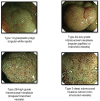A step-by-step guide to approaching colon polyps
- PMID: 37767319
- PMCID: PMC10520385
- DOI: 10.22037/ghfbb.v16i2.2512
A step-by-step guide to approaching colon polyps
Abstract
Colorectal cancer (CRC) is considered one of the most prevalent cancers among Iranian men and women (1). Colorectal polyps, known as precursors of CRCs, are of great importance. Surveillance, locating, and removal of colorectal polyps make them the most modifiable factor apart from other genetic and environmental factors leading to CRCs. Colorectal polyps are defined as outpouchings from superficial and deep layers of mucosa of the colonic wall. They are classified as adenomas, serrated polyps, hyperplastic polyps, and hamartomas based on histological evaluation. Submucosal invasion precludes the possibility of endoscopic resection and should be ruled out via colonoscopic evaluation (2). Knowing this significance, the present study aims to present a brief review on classification, probability of endoscopic resection, complications of endoscopic polypectomy, as well as proper surveillance after polypectomy.
Keywords: Colorectal polyps; Deep mural injury.; JNET classification; Kudo pit pattern; NICE classification; Paris classification.
© 2023, Gastroenterology and Hepatology From Bed to Bench (GHFBB).
Conflict of interest statement
The authors declare that they have no conflict of interest.
Figures









Similar articles
-
Through the Looking Glass: Surveillance Following Colonoscopic Polypectomy of Malignant Polyps.Cureus. 2023 Apr 23;15(4):e38027. doi: 10.7759/cureus.38027. eCollection 2023 Apr. Cureus. 2023. PMID: 37228528 Free PMC article.
-
Classification of image-enhanced endoscopy in colon tumors.Clin Endosc. 2025 May;58(3):337-351. doi: 10.5946/ce.2024.263. Epub 2025 May 8. Clin Endosc. 2025. PMID: 40336268 Free PMC article. Review.
-
Do surface morphology and pit pattern have a role in predicting cancer for colon polyps in North America?Surg Endosc. 2023 Mar;37(3):2354-2358. doi: 10.1007/s00464-023-09866-2. Epub 2023 Jan 29. Surg Endosc. 2023. PMID: 36710285
-
Colon mucosal neoplasia referred for endoscopic mucosal resection: Recurrence of adenomas and prediction of submucosal invasion.World J Gastrointest Endosc. 2020 Jul 16;12(7):198-211. doi: 10.4253/wjge.v12.i7.198. World J Gastrointest Endosc. 2020. PMID: 32733641 Free PMC article.
-
Serrated lesions of the colon and rectum: the role of advanced endoscopic imaging.Best Pract Res Clin Gastroenterol. 2015 Aug;29(4):675-86. doi: 10.1016/j.bpg.2015.05.009. Epub 2015 Jun 4. Best Pract Res Clin Gastroenterol. 2015. PMID: 26381311 Review.
Cited by
-
Adenoma per polypectomy as a training metric in colonoscopy: a retrospective analysis of trainee progression compared to expert performance.Ann Surg Treat Res. 2025 Aug;109(2):113-119. doi: 10.4174/astr.2025.109.2.113. Epub 2025 Jul 30. Ann Surg Treat Res. 2025. PMID: 40785808 Free PMC article.
References
-
- Meseeha M, Attia M. Colon polyps. Treasure Island (FL): StatPearls Publishing; 2021. - PubMed
-
- The Paris endoscopic classification of superficial neoplastic lesions: esophagus, stomach and colon. Gastroint Endosc. 2003;58:3–43. - PubMed
-
- Gupta S. Trouble in Paris classification: polyp morphology is in the eye of the beholder. Am J Gastroenterol. 2015;110:188–91. - PubMed
-
- Oka S, Tanaka S, Kanao H, Oba S, Chayama K. Therapeutic strategy for colorectal laterally spreading tumor. Dig Endosc. 2009;21:43–46. - PubMed
LinkOut - more resources
Full Text Sources
